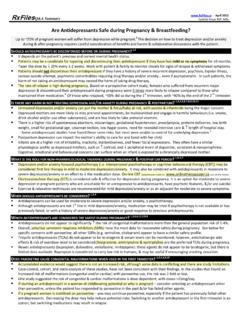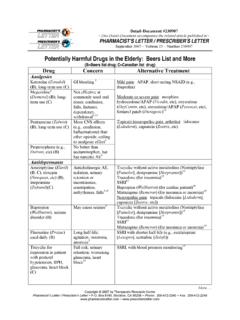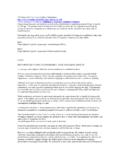Transcription of Antidepressants - TCAs, MAOIs, SSRIs & SNRIs First ...
1 Antidepressants - TCAs, MAOIs, SSRIs & SNRIs First generation Antidepressants TCAs and MAOIs The discovery of Antidepressants could be described as a lucky accident . During the 1950s, while carrying out trials on a new medication for tuberculosis (TB), researchers noticed that the medication also had a mood improving effect. This initial discovery led to the creation of two classes of First generation Antidepressants : Tricyclic Antidepressants (TCAs), of which the most widely used type was: Amitriptyline Dosulepin Monoamine Oxidase Inhibitors (MAOIs),of which the two most widely used types were: Moclobemide Phenelzine.
2 Both TCAs and MAOIs proved to be effective in treating depression, but they did cause a wide range of side effects, which were often unpleasant. These included: constipation, sweating, shaking or trembling, and difficulty sleeping. Second generation Antidepressants SSRIs The second generation of Antidepressants , which are collectively known as Selective Serotonin Reuptake Inhibitors (SRRIs), were introduced at the beginning of the 1980s. Commonly used were: Fluoxetine (Prozac) Citalopram Paroxetine Sertraline SSRIs quickly became widely used instead of TCAs and MAOIs as they were considered to cause far less troublesome side effects.
3 Third generation Antidepressants SNRIs The third generation of Antidepressants , which are collectively known as Serotonin-Norepinephrine Reuptake Inhibitors ( SNRIs ), were introduced during the 1990s. Examples of SNRIs include: Venlafaxine Mirtazapine SNRIs were the result of an attempt to create an antidepressant that was more clinically effective than SSRIs . However, the evidence that SNRIs are more effective at treating everyone with depression is uncertain. How Antidepressants work Different types of Antidepressants work in different ways, but all Antidepressants are based on the same principle.
4 All Antidepressants work by increasing the levels of chemicals called neurotransmitters in the brain. Neurotransmitters are messenger chemicals that are used to transmit signals between brain cells. Some neurotransmitters are also thought to have an important effect on your mood. Examples of mood enhancing neurotransmitters include: Serotonin Norepinephrine dopamine The role that these neurotransmitters play in the causes of depression (and other mental health conditions) is still poorly understood. However, most experts would say that depression is not simply the result of a chemical imbalance in the brain.
5 Depression is a complex condition with many contributing factors. While Antidepressants can treat the symptoms of depression, they do not necessarily address its causes. This is why Antidepressants are usually used in combination with therapy to treat moderate to severe depression or other mental health conditions. Increasing the levels of neurotransmitters is a gradual process, so most people will need to take Antidepressants for two to four weeks before noticing any improvement in their symptoms. Increasing the levels of neurotransmitters can disrupt the pain signals that are sent by the nerves, which may be why some Antidepressants are used to help relieve symptoms of chronic (long-term) pain.
6 Antidepressants and suicide risk Some people have experienced suicidal thoughts and a desire to self-harm when they First start to take Antidepressants . Those who are under 25 years of age seem to be particularly at risk. It may be useful to tell a relative or a close friend that you have started taking Antidepressants and to ask them to read the leaflet that comes with your medication. You should then ask them to tell you if they think your symptoms are getting worse, or if they are worried about changes in your behaviour. MAOIs Common side effects of Monoamine Oxidase Inhibitors (MAOIs) include: blurred vision dizziness drowsiness increased appetite nausea restlessness shaking or trembling difficulty sleeping TCAs Common side effects of Tricyclic Antidepressants (TCAs) include: dry mouth constipation sweating problems passing urine slight blurring of vision drowsiness SSRIs Common side effects of Selective Serotonin Reuptake Inhibitors ( SSRIs ) include.
7 Nausea (feeling sick) low sex drive blurred vision diarrhoea or constipation dizziness dry mouth feeling agitated or shaky insomnia (not sleeping well) or feeling very sleepy loss of appetite (not feeling hungry) sweating yawning SNRIs The common side effects of Serotonin-Norepinephrine Reuptake Inhibitors ( SNRIs ) are the same as those that are associated with SSRIs (see above). Antidepressants may have a part to play in helping you to deal with the unpleasant symptoms of depression and some people may take them for months or even years. There are however other methods which you may find more suitable, including talking treatments, relaxation or alternative therapies.
8 In addition, for those whose depression may be related to housing, financial or other social or emotional problems, practical resolution of these difficulties might be the best way to shift the depression, rather than resorting to medication. Discuss the various alternatives with your doctor or therapist. Antidepressants may cause unpleasant side effects (see above), which may distress or worry you. These symptoms may arise before there is any beneficial effect of the drug, which may take up to 4 weeks to work fully. If you are prescribed an antidepressant for the First time you should ask your doctor about any side effects you may expect when you start the medication.
9 Whilst Antidepressants are not addictive in the same way as hard drugs, you may experience a cluster of symptoms on stopping antidepressant treatment. This is known as discontinuation syndrome. It is therefore essential to come off your Antidepressants slowly if you have been taking them for 2 or 3 months or longer. The rate of withdrawal will vary according to which drug you have been taking, for how long and in what quantity. The safest way is to make small reductions in the amount taken at intervals of a few weeks, to ensure that any withdrawal symptoms are kept to a minimum. Too rapid withdrawal can result in severe symptoms such as major anxiety or panic attacks, insomnia, sickness, lack of concentration, depersonalisation and even suicidal feelings.
10 Discuss these immediately with your doctor if you are worried about them. Over the past 15 years the Committee on Safety of Medicines has received an unprecedented number of reports about dependence-related problems with SSRI s and other new Antidepressants . The SSRI s and other new Antidepressants account for 5 of the 6 top drugs for which withdrawal reactions have been reported worldwide. The highest number of adverse reactions have been reported with Paroxetine (Seroxat). The second highest number are with Venlafaxine (Efexor). Prescribing of Antidepressants has quadrupled over the past 20 years.





